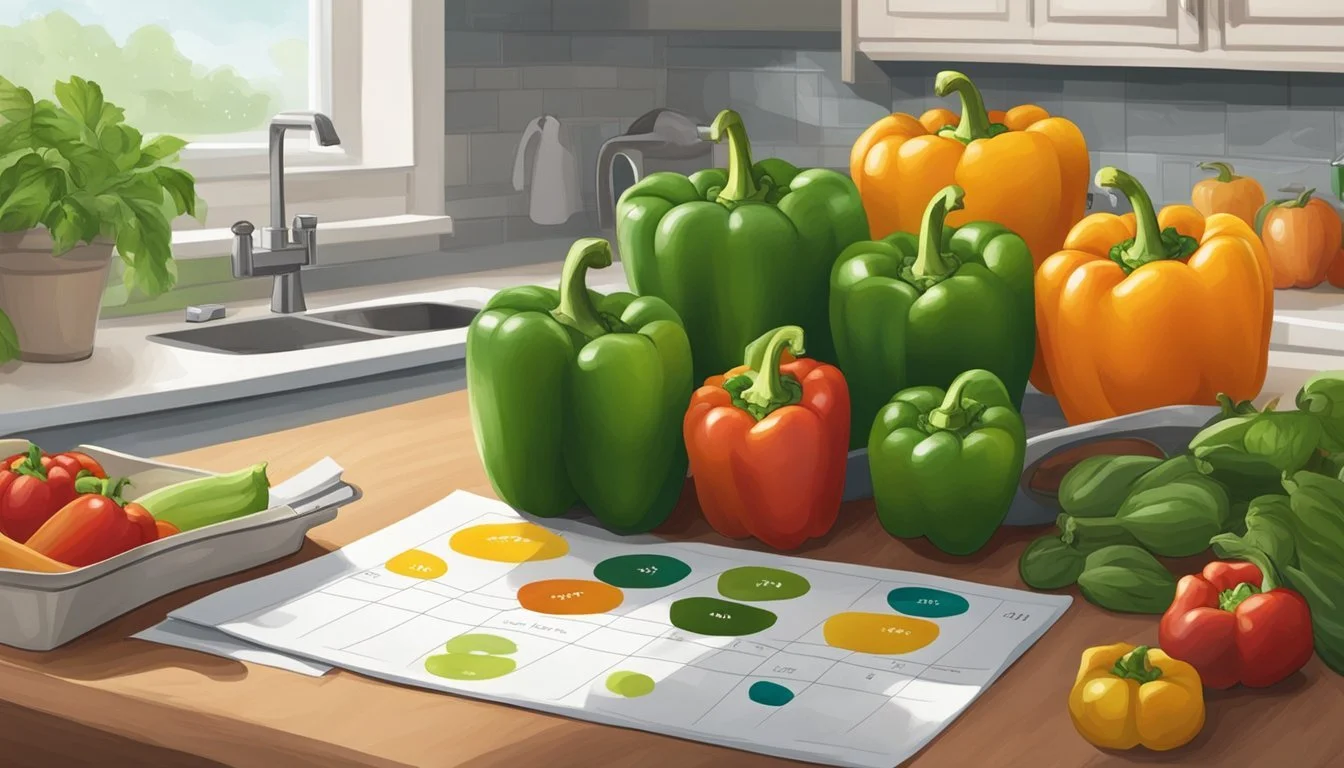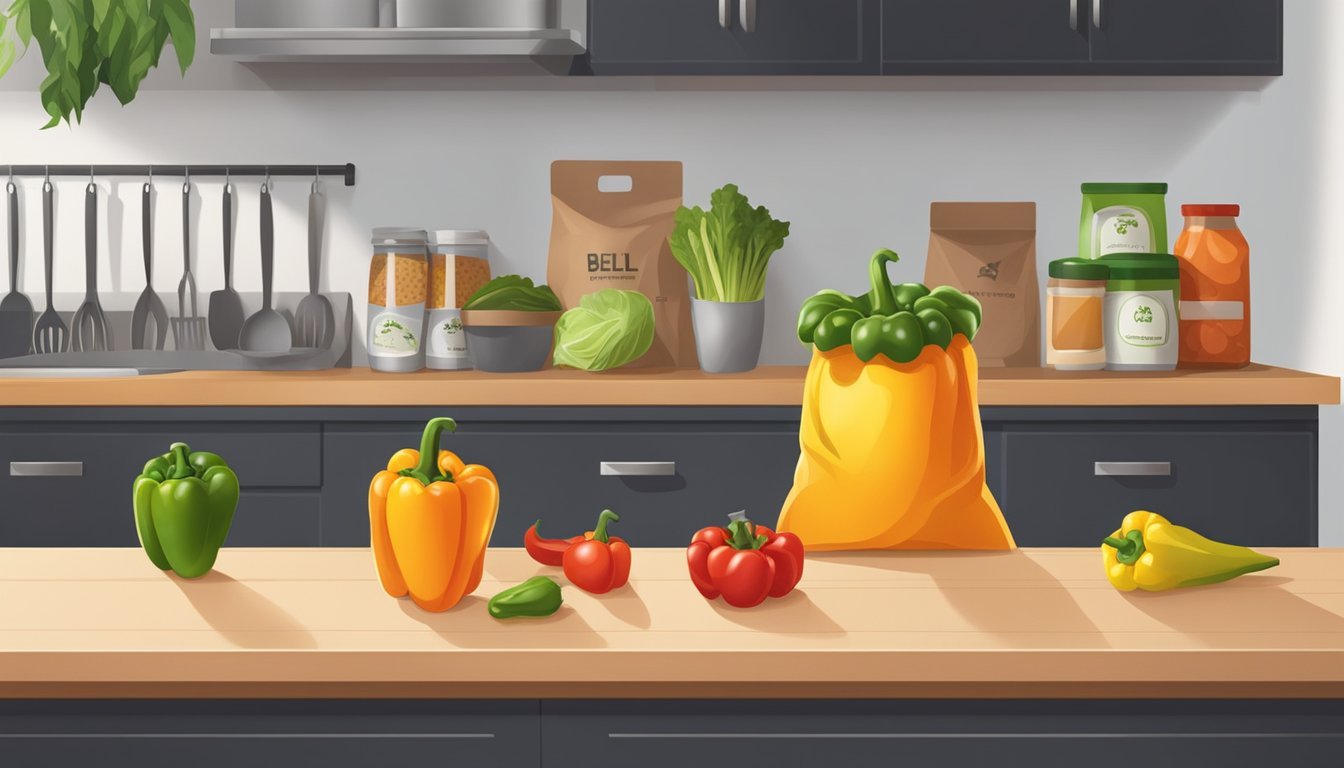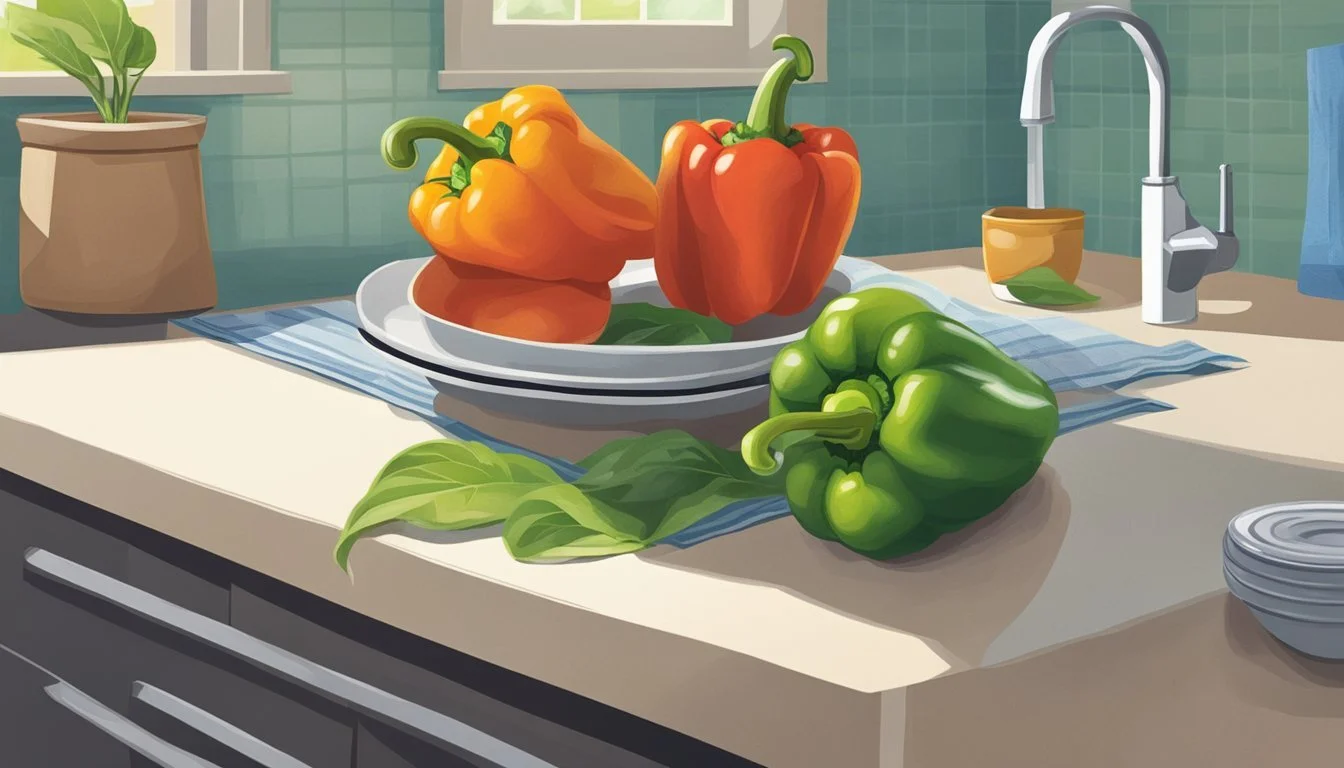How Long Do Bell Peppers Last?
Shelf Life and Storage Tips
Bell peppers (What wine goes well with bell peppers?), known for their vibrant colors and sweet to mildly spicy taste, are a staple in kitchens around the world. Packed with nutrients, they are used in a variety of dishes from stir-fries to salads. The shelf life of bell peppers, however, is a concern for those looking to maintain the freshness and flavor of this versatile vegetable. Factors that affect the longevity of bell peppers include the method of storage, whether they are whole or cut, and the type of bell pepper.
Refrigeration is key to extending the life of bell peppers. When stored properly in the refrigerator, whole bell peppers can last up to two weeks. It's important to note that the condition of the peppers at the time of purchase can influence their longevity. Peppers that are firm and free of blemishes are more likely to reach the two-week mark. On the other hand, leftover cooked bell peppers should be kept in an airtight container and can be expected to last for three to four days in the fridge.
Freezing bell peppers is an effective way to preserve them for an extended period. When stored in the freezer, chopped bell peppers can maintain their quality for four to six months. To maximize freshness, proper storage techniques before freezing ensure that the peppers retain their nutritional value and flavor when they are later thawed and used in cooking.
Bell Pepper Basics
Bell peppers are a versatile and colorful addition to a wide variety of dishes, prized for their sweet flavor and crunchy texture. Understanding their identification, nutritional profile, and ripeness indicators is crucial for proper selection and use.
Identification and Varieties
Bell peppers are easily recognized by their glossy exterior and blocky shape, comprising three to four lobes. They come in a spectrum of colors, including green, red, yellow, purple, and even white. The various colors of bell peppers actually represent different stages of maturity. Green bell peppers are unripe and have a slightly bitter flavor. As they ripen, their color can change to yellow, then to orange, and finally to a vibrant red, with each color shift bringing about a sweeter and milder taste. Purple and white varieties are less common and have unique flavors compared to the more traditional colors.
Nutritional Value
Bell peppers are low in calories and rich in vitamins and minerals. Here is a simplified nutritional breakdown for a typical bell pepper:
Calories: Low
Vitamins: High in Vitamin C and Vitamin A
Minerals: Contains potassium and folic acid
Dietary fiber: Good source
Antioxidants: Abundant in carotenoids and flavonoids
Their high vitamin C content, especially in red bell peppers, makes them an excellent choice for supporting the immune system and skin health.
Bell Pepper Ripeness
The ripeness of a bell pepper not only affects its flavor but also its nutritional value. Unripe, green bell peppers have a sharper taste and are firmer in texture. As they mature, their sugars develop, resulting in the red, yellow, and orange peppers having a sweeter flavor and higher vitamin C content. The skin of a ripe bell pepper should be taut and free of blemishes, indicating that it is at its peak freshness and ready for consumption. When selecting bell peppers, one should also inspect the stem, which should be green and fresh-looking, not dried or shriveled.
Purchasing and Storage Fundamentals
When selecting and storing bell peppers, it's essential to consider factors that affect longevity such as ripeness, storage location, and method of wrapping.
Selecting Bell Peppers at the Store
At the grocery store or farmers market, choose bell peppers with firm skin, vivid color, and no blemishes. Green bell peppers, which are less ripe, tend to last longer than red, yellow, or orange ones. Checking for a taut skin and avoiding peppers with wrinkles or soft spots can ensure one is selecting the freshest produce available.
Optimal Storage Techniques
Bell peppers should be stored in the refrigerator's crisper drawer to maintain humidity and crispness. For the longest shelf life, place them in a produce bag or wrap them loosely in a paper towel before refrigerating to absorb excess moisture. This is crucial to prevent spoilage from condensation.
Refrigerator vs. Counter Storage
Bell peppers last longer when stored in the fridge rather than at room temperature. If left on the counter, bell peppers can soften and lose their crispness within days, whereas the refrigerator can significantly extend their freshness for up to two weeks, especially when stored properly in the crisper drawer.
Extending Freshness with Proper Wrapping
To extend the freshness of cut bell peppers, one should store them in an airtight container with a paper towel to absorb moisture. If storing whole bell peppers, placing them in a plastic bag with holes for air circulation can also help maintain their condition. It's important to note that once cut, bell peppers should be consumed within 1-3 days for optimal taste and texture.
Understanding Bell Pepper Shelf Life
The shelf life of bell peppers varies greatly depending on whether they are whole or cut. Storage methods and proper handling significantly affect how long a bell pepper remains fresh and firm.
Whole Bell Peppers
Whole bell peppers, when stored in a refrigerator, typically last between one to two weeks. It is crucial to maintain them in their raw, whole state without any cuts to maximize their freshness. They should be kept in the crisper drawer of the refrigerator to retain their firmness and freshness. Bell peppers thrive in a cool, not cold, environment as excessive cold may damage their texture.
Cut Bell Peppers
Once cut, bell peppers have a shorter shelf life due to their exposed flesh which can deteriorate more quickly. Typically, cut bell peppers last in the refrigerator for 1 to 3 days when kept in an airtight container. Exposure to air can lead to them losing their firm texture and freshness more rapidly. To preserve their quality for as long as possible, ensure they are sealed tightly and refrigerated promptly after cutting.
Preventing Spoilage
Ensuring bell peppers last as long as possible requires vigilance for signs of spoilage, managing moisture levels, and applying mold prevention techniques.
Signs of a Bad Bell Pepper
One can identify a rotten bell pepper by checking for soft spots and dark areas on the skin, a sign indicative of internal decay. A wrinkled surface or a pepper that has lost its firmness may be nearing spoilage. Additionally, mold growth on the pepper, particularly white, brown, or green mold, either inside or out, mandates immediate disposal for food safety.
Handling Excess Moisture and Humidity
To address excess moisture and humidity, which accelerate spoilage, one should store cut bell peppers in an airtight container lined with a paper towel to absorb moisture. Maintaining the right moisture content is crucial; too much humidity can lead to faster decay while too little can dry them out and reduce their shelf life.
Mold Prevention Tactics
Applying mold prevention strategies is key. Bell peppers should be kept in a cool, dry place, and if they are refrigerated, they should be in the vegetable crisper where the humidity is more controlled. Peppers should be checked regularly for signs of mold, and any affected peppers should be thrown away to prevent mold from spreading to other produce.
Advanced Storage Techniques
For those looking to maximize the shelf life of bell peppers, freezing and long-term storage solutions offer effective methods. These techniques preserve the peppers' freshness for use beyond their typical refrigerated lifespan.
Freezing Procedures
Freezing is an ideal method for preserving bell peppers, and it involves several key steps:
Wash: Start by thoroughly cleaning the peppers to remove any dirt.
Slice or Chop: Cut the peppers to the desired size, which can be halves, slices, or diced pieces, depending on intended future use.
Blanching (Optional): Some prefer to blanch peppers by boiling them for a few minutes and then quickly placing them in ice water. This can help retain color and texture.
Dry: Ensure the pieces are completely dry to prevent freezer burn.
Flash Freeze: Spread the pepper pieces on a baking sheet in a single layer to freeze them individually. This prevents clumping.
Bagging: Once the peppers are frozen, transfer them to a freezer-safe bag, removing as much air as possible before sealing.
The result is evenly frozen bell peppers that are easy to use in future meal preparations.
Long-Term Storage Solutions
For long-term storage, maintaining the quality of bell peppers in the freezer is critical:
Temperature: Keep the freezer at a consistent 0°F (-18°C).
Packaging: Use airtight containers or freezer bags to protect against freezer burn.
Labeling: Clearly mark the freeze date to keep track of how long the peppers have been stored.
Maintenance: Regularly check for signs of freezer burn or ice crystals, which can impact the peppers' quality over time.
Frozen bell peppers can last for up to a year when properly stored, ensuring a ready supply for a variety of recipes.
Preparation and Usage Tips
Proper preparation enhances the flavor and longevity of bell peppers. They can be incorporated into an array of dishes, whether raw or cooked, serving as a vibrant component in salads or a savory element in a dip.
Washing and Cutting Bell Peppers
Before using bell peppers in any recipe, they should be thoroughly washed under cold water to remove any dirt or pesticides. After washing, the stems, seeds, and membranes are typically removed. One can then slice the peppers into rings or strips, or cut them into chunks depending on the recipe's requirements. It's important to use a sharp knife and a stable cutting board for safety and precision.
Wash: Run cold water over the bell peppers, gently rubbing their surface.
Cut: Remove the top and bottom, slice in half, eliminate seeds and membranes, and proceed as recipe dictates.
Cooking with Bell Peppers
Bell peppers are highly versatile and can be used in a variety of cuisines. They can be sautéed, roasted, or grilled to enrich their natural sweetness. For cooked applications, bell peppers are often sliced or chopped to ensure even cooking. When using bell peppers in a salad, they are typically used raw to add a crisp texture. Bell peppers also make a nutritious and flavorful addition to dips when they are minced or pureed.
Sauté: Medium-high heat for a short duration retains color and texture.
Roast: Roasting at high temperatures until the skin blisters brings out a smoky sweetness.
Raw: Thin slices or diced pieces work well for salads and dips.
Maximizing Bell Pepper Lifespan
Proper storage and handling can significantly extend the life of bell peppers, especially when specific measures are tailored to the variety and ripeness of the pepper.
Green Bell Pepper Specifics
Green bell peppers often last longer than their red, yellow, and orange counterparts, remaining fresh for 2-3 weeks in the refrigerator if they retain their stem and seeds. To preserve their freshness, one should store them in the vegetable drawer of the refrigerator, away from excess moisture that could encourage decay.
Handling Bell Peppers After Ripening
After a bell pepper has reached its full ripeness, the crucial window to use it at its optimal freshness begins, and handling it properly is key to extending its life. Store ripe bell peppers in a sealed plastic bag in the crisper section of the refrigerator, making sure that the date of storage is noted to keep track of its remaining shelf life.ews only when it is relevant and accurate. Do not plagiarize any of the content.
Quality and Safety Considerations
When assessing bell peppers for both quality and safety, individuals should pay attention to texture and visual changes. Monitoring the condition of bell peppers is essential to ensure they are safe for consumption, and understanding USDA guidelines helps to determine their shelf life.
Monitoring Bell Pepper Condition
One must inspect bell peppers regularly for signs of spoilage such as wrinkles or discoloration. A fresh bell pepper should have a firm texture and a vivid color. If the pepper has wrinkles or has become soft, it may be an indication that it is losing its freshness and nutritional value. Discoloration can sometimes be a sign of beginning spoilage. As bell peppers decline in quality, they may not only lose their crispness but could also become less flavorful and potentially unsafe to eat.
Understanding the USDA Guidelines
The USDA provides clear guidelines for the storage and consumption of bell peppers. By following these, consumers can use precautions to ensure food safety. According to the USDA, bell peppers can last in the refrigerator for up to two weeks if stored properly. However, once cut, their shelf life decreases to 1-3 days. It is advisable to exercise caution and consume bell peppers while they're at their peak in quality to avoid potential foodborne illness. All types of bell peppers, regardless of their color, should be stored in a refrigerator to maximize shelf life and maintain quality.







